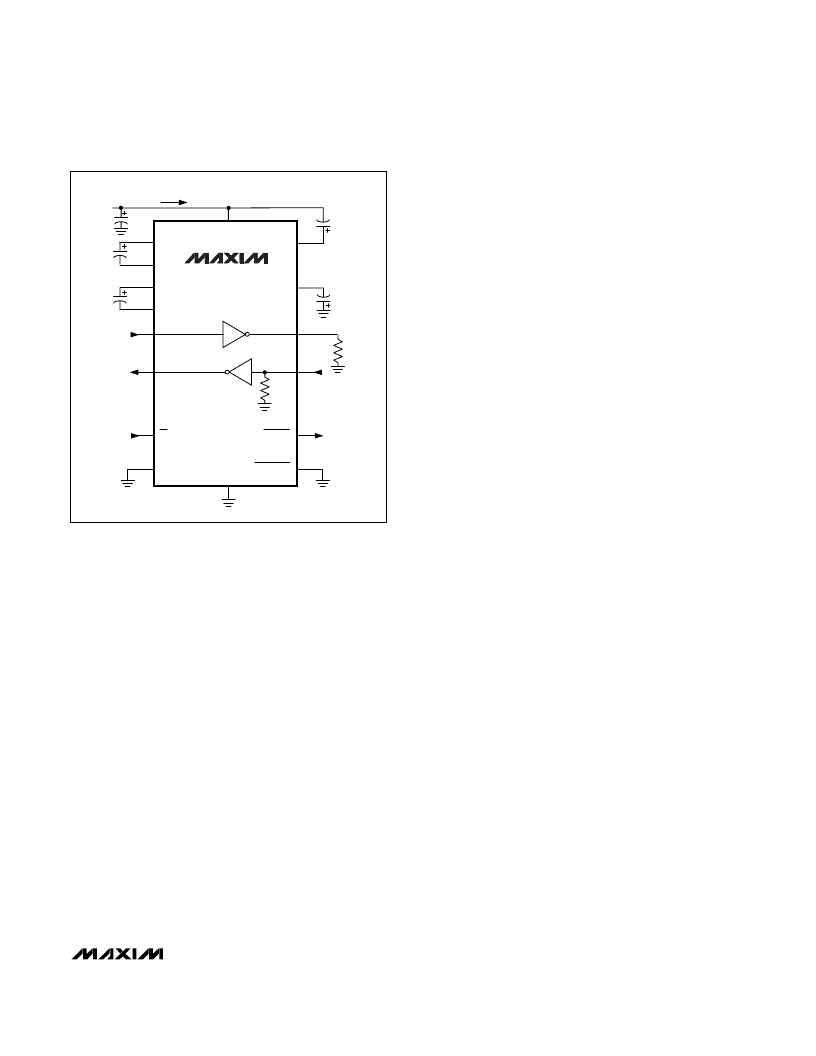- 您現(xiàn)在的位置:買(mǎi)賣(mài)IC網(wǎng) > PDF目錄383345 > MAX221ECUE (MAXIM INTEGRATED PRODUCTS INC) 【15kV ESD-Protected, +5V, 1レA, Single RS-232 Transceiver with AutoShutdown PDF資料下載
參數(shù)資料
| 型號(hào): | MAX221ECUE |
| 廠商: | MAXIM INTEGRATED PRODUCTS INC |
| 元件分類(lèi): | 通用總線功能 |
| 英文描述: | 【15kV ESD-Protected, +5V, 1レA, Single RS-232 Transceiver with AutoShutdown |
| 中文描述: | LINE TRANSCEIVER, PDSO16 |
| 封裝: | 4.40 MM, 0.65 MM PITCH, TSSOP-16 |
| 文件頁(yè)數(shù): | 5/12頁(yè) |
| 文件大?。?/td> | 177K |
| 代理商: | MAX221ECUE |

M
±15kV ESD-Protected, +5V, 1μA, Single RS-232
Transceiver with AutoShutdown
_______________________________________________________________________________________
5
_______________Detailed Description
Dual Charge-Pump Voltage Converter
The MAX221E’s internal power supply consists of a
dual charge pump that provides a positive output volt-
age (doubling charge pump) and negative output volt-
age (inverting charge pump) from a single +5V supply.
The charge pumps operate in continuous mode. Each
charge pump requires a flying capacitor (C1, C2) and a
reservoir capacitor (C3, C4) to generate the V+ and V-
supplies.
RS-232 Transmitter
The transmitter is an inverting level translator that con-
verts CMOS-logic levels to 5.0V EIA/TIA-232 levels. It
guarantees a 250kbps data rate with worst-case loads
of 3k
in parallel with 1000pF.
When
FORCEOFF
is driven to ground, or when the
AutoShutdown circuitry senses invalid voltage levels on
the receiver input, the transmitter is disabled and the
output is forced into a high-impedance state. The trans-
mitter input does not have a pull-up resistor.
RS-232 Receiver
The MAX221E’s receiver converts RS-232 signals to
CMOS-logic output levels. The receiver has an inverting
three-state output and can be active or inactive. In
shutdown (
FORCEOFF
= low) or in AutoShutdown, the
receiver is active (Table 1). Drive
EN
high to place the
receiver in a high-impedance state. The receiver is
high-impedance when the MAX221E is in shutdown
(
FORCEOFF
= low).
The MAX221E’s
INVALID
output is pulled low when
there is no valid RS-232 signal level detected on the
receiver input.
INVALID
is functional in any mode
(Figures 2 and 3).
AutoShutdown
The MAX221E achieves 1μA supply current with
Maxim’s AutoShutdown feature, which operates when
FORCEON is low and
FORCEOFF
is high. When the
device senses no valid signal levels on the receiver
input for 30μs, the on-board charge pump and driver
are shut off, reducing supply current to 1μA. This
occurs if the RS-232 cable is disconnected or the con-
nected peripheral transmitter is turned off. The
MAX221E turns on again when a valid level is applied
to the RS-232 receiver input. As a result, the system
saves power without changes to the existing BIOS or
operating system.
Table 1 and Figure 2c summarize the MAX221E operat-
ing modes. FORCEON and
FORCEOFF
override
AutoShutdown. When neither control is asserted, the
device selects between these states automatically,
based on the receiver input level. Figures 2a, 2b, and
3a depict valid and invalid RS-232 receiver levels.
Figure 3 shows the input levels and timing diagram for
AutoShutdown operation.
A device or another system with AutoShutdown con-
nected to the MAX221E may need time to wake up.
Figure 4 shows a circuit that forces the transmitter on
for 100ms, allowing enough time for the other system to
realize that the MAX221E is awake. If the other system
transmits valid RS-232 signals within that time, the
RS-232 ports on both systems remain enabled.
When shut down, the device’s charge pumps turn off,
V+ is pulled to V
CC
, V- is pulled to ground, and the
transmitter output is high impedance. The time required
to exit shutdown is typically 100μs (Figure 3b).
MAX221E
FORCEON
EN
12
1
ROUT
I
SHDN
9
FORCEOFF
16
INVALID
10
GND
14
TIN
11
C2-
6
C2+
5
C1-
4
C1+
2
RIN 8
TOUT
13
V-
7
V+
3
V
CC
C4
0.1
μ
F
15
C1
0.1
μ
F
C2
0.1
μ
F
C
BYPASS
0.1
μ
F
+5V
TO POWER-
MANAGEMENT
UNIT
5k
3k
C3
0.1
μ
F
Figure 1. Shutdown Current Test Circuit
相關(guān)PDF資料 |
PDF描述 |
|---|---|
| MAX221EEUE | 16-Bit Buffers/Drivers With 3-State Outputs 48-TVSOP -40 to 85 |
| MAX221EEAE | 【15kV ESD-Protected, +5V, 1レA, Single RS-232 Transceiver with AutoShutdown |
| MAX221 | Quadruple Bus Buffer Gates With 3-State Outputs 14-TSSOP -40 to 85 |
| MAX221CAE | %V, 1レA, Single RS-232 Transceiver with AutoShutdown |
| MAX221CUE | Quadruple Bus Buffer Gates With 3-State Outputs 14-TSSOP -40 to 85 |
相關(guān)代理商/技術(shù)參數(shù) |
參數(shù)描述 |
|---|---|
| MAX221ECUE+ | 功能描述:RS-232接口集成電路 15kV ESD-Protected 5V 1uA RS-232 Trx RoHS:否 制造商:Exar 數(shù)據(jù)速率:52 Mbps 工作電源電壓:5 V 電源電流:300 mA 工作溫度范圍:- 40 C to + 85 C 安裝風(fēng)格:SMD/SMT 封裝 / 箱體:LQFP-100 封裝: |
| MAX221ECUE+T | 功能描述:RS-232接口集成電路 15kV ESD-Protected 5V 1uA RS-232 Trx RoHS:否 制造商:Exar 數(shù)據(jù)速率:52 Mbps 工作電源電壓:5 V 電源電流:300 mA 工作溫度范圍:- 40 C to + 85 C 安裝風(fēng)格:SMD/SMT 封裝 / 箱體:LQFP-100 封裝: |
| MAX221ECUE-T | 功能描述:RS-232接口集成電路 RoHS:否 制造商:Exar 數(shù)據(jù)速率:52 Mbps 工作電源電壓:5 V 電源電流:300 mA 工作溫度范圍:- 40 C to + 85 C 安裝風(fēng)格:SMD/SMT 封裝 / 箱體:LQFP-100 封裝: |
| MAX221EEAE | 功能描述:RS-232接口集成電路 RoHS:否 制造商:Exar 數(shù)據(jù)速率:52 Mbps 工作電源電壓:5 V 電源電流:300 mA 工作溫度范圍:- 40 C to + 85 C 安裝風(fēng)格:SMD/SMT 封裝 / 箱體:LQFP-100 封裝: |
| MAX221EEAE+ | 功能描述:RS-232接口集成電路 15kV ESD-Protected 5V 1uA RS-232 Trx RoHS:否 制造商:Exar 數(shù)據(jù)速率:52 Mbps 工作電源電壓:5 V 電源電流:300 mA 工作溫度范圍:- 40 C to + 85 C 安裝風(fēng)格:SMD/SMT 封裝 / 箱體:LQFP-100 封裝: |
發(fā)布緊急采購(gòu),3分鐘左右您將得到回復(fù)。